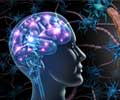A new study has found that a breakdown of myelin is associated with the early evolution of Huntington's disease. Last month, Dr. George Bartzokis, director of the UCLA Memory Disorders and Alzheimer's Disease Clinic, suggested in the journal Alzheimer's and Dementia that the collapse of a type of myelin that develops late in life promotes the enlargement of toxic amyloid plaques long associated with Alzheimer's disease. Myelin is the "insulation" that wraps around nerve axons in the brain.
Now, in a new report presently online in the journal Neurochemical Research, Bartzokis turns his concentration to Huntington's disease. Again, he suggests that a breakdown of myelin is the cause, but with a twist - it is the myelin that develops early in the formation of the brain that breaks down ahead of time and ultimately leads to the disease's symptoms.Huntington's disease (HD) is an uncommon, inherited neurological disorder that eventually deprives individuals of their ability to be in charge of their movement, behaviour and thinking. It affects around 30,000 people in the U.S., with another 150,000 at risk.
While it is known that HD is caused by a mutation in a gene called Huntingtin (Htt), the correct mechanism by which the Htt gene causes or contributes to neuronal cell death and HD symptoms remains uncertain. Bartzokis' research suggests that it is Htt's influence on myelin that may prove to be the cause.
The earliest parts of the developing brain include systems of neurons that control movement and behaviour. These neurons have long axons, finger-like projections that serve as the main transmission lines of the nervous system, covered with thick myelin sheaths. The sheaths are nourished by an ongoing supply of a protein called brain-derived neurotrophic factor, which travels down a neuron's axon.
Bartzokis believes that the Htt gene gets in the way of this nourishment-delivery system, causing a breakdown of the myelin that depends on it. That, consecutively, upsets cell signalling, which results in the neuron's death.
The problem is compounded by the recurrent production of other cells that carry on making myelin. In HD, increasing numbers of these cells, called oligodendrocytes, are created in an effort to remyelinate axons whose myelin sheaths have broken down. This results in markedly elevated numbers of oligodendrocytes years before the appearance of HD symptoms.
Advertisement
To spot myelin destruction, neuron death and iron accumulation in the brains of HD subjects, Bartzokis used two magnetic resonance imaging (MRI) machines operating at different field strengths. Measurements of myelin breakdown and iron content were taken from the brains of 11 HD subjects and compared to a control group of 27 subjects. Bartzokis found that both the breakdown and the iron accumulation matched the typical progression of the disease from early to late myelinating regions.
Advertisement
The implications of this are significant, Bartzokis noted, since there is a decades-long period during which therapeutic interventions could alter the course of the disease, long before clinical evidence - such as behavioral, cognitive and motor problems - appear. Thus, it may be achievable to build up medication that could be controlled in the very early stages using non-invasive in vivo neuroimaging markers of both myelin breakdown and levels of iron.
Source-ANI
LIN/M






